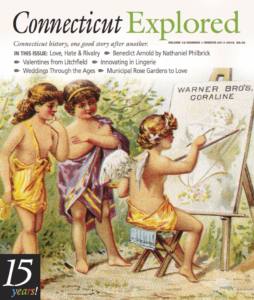By Walter W. Woodward
(c) Connecticut Explored Inc. Winter 2017-2018
Subscribe/Buy the Issue!
In the fall of 1858, William Ransom was really homesick. Like tens of thousands of Connecticans affected during the first half of the 19th century by such issues as tapped-out farmland, economic downturns, high taxation, climate change, and political repression, he had left Connecticut in search of a better life. He’d made his way to the start-up town of Galesburg in southern Illinois, becoming over time so successful there that people called him “squire.” But that fall, instead of reveling in his achievements, Ransom found himself longing for the place that had given him birth and shaped his most fundamental values. He missed Connecticut. And he wondered if there were others in Illinois who felt the same.
 A man of action, Ransom made a plan to find out, He talked to other expatriates, and as he recorded in a report of the Connecticut Association in 1860, they formed a committee to invite “all persons of Connecticut birth, and all heads of families of which either the husband or wife may be of Connecticut origin” to come to a “Connecticut Festival” consisting of a “Social Interview” at three o’clock, followed by a “Pic Nic Supper” at six, whose offerings were to be brought by the participants. The event was to be held on January 7, 1859, the birthday of Connecticut Revolutionary war hero Israel Putnam. Those who came were asked to bring “paintings, relics, or other articles calculated to revive associations connected with the parent State.” More committees were formed—focusing on such matters as arrangements, tables, toasts, and invitations. And a band—made up of Connecticut-born musicians—was engaged. But would anybody come?
A man of action, Ransom made a plan to find out, He talked to other expatriates, and as he recorded in a report of the Connecticut Association in 1860, they formed a committee to invite “all persons of Connecticut birth, and all heads of families of which either the husband or wife may be of Connecticut origin” to come to a “Connecticut Festival” consisting of a “Social Interview” at three o’clock, followed by a “Pic Nic Supper” at six, whose offerings were to be brought by the participants. The event was to be held on January 7, 1859, the birthday of Connecticut Revolutionary war hero Israel Putnam. Those who came were asked to bring “paintings, relics, or other articles calculated to revive associations connected with the parent State.” More committees were formed—focusing on such matters as arrangements, tables, toasts, and invitations. And a band—made up of Connecticut-born musicians—was engaged. But would anybody come?
January 7 dawned inauspiciously, for the day proved to be “one of the coldest and severest of the season.” Only the hardiest dared venture out. But venture out they did. To nearly everyone’s astonishment, more than 300 former Connecticans showed up in Galesburg that snowbound day, ranging from “the old, sedate and wrinkled” to the “young, beautiful, and accomplished.” Their potluck contributions created a massive New England feast that included among a cornucopia of other dishes, oysters, baked beans, turkey, pumpkin and apple pies, fried cakes, and cranberry sauce. One cake, nearly two-and-a-half feet high, was emblazoned with the words “Nutmeg State,” and around its base were wooden nutmegs and cucumber seeds “sufficient to deceive a practiced eye.”
Toasts were given in profusion, among them: to “Connecticut, our common mother, home of our brightest hours;” to “The Charter Oak, may it ever live in the memory of all;” to “The Connecticut River—the Mississippi of New England,” “the Daughters of Connecticut,” the “Sons of Connecticut,” and “their Yankee genius.” Even the town of Vernon was toasted by a man named Sage, who praised his hometown for furnishing the “Sages of the West.” Each toast was followed by a short disquisition elaborating on its significance and meaning. That in turn was followed by a musical interlude of songs such as “The Connecticut Peddler” and “Old 100.”
When the party ended some time after midnight, participants agreed they had enjoyed a “feast of reason and a flow of the soul,” and the Sons and Daughters of Connecticut as an organization was born.
A year later, on January 7, 1860, they met again, and despite an ice storm that made many would-be attendees unable to travel, another 300 people made it to the event and held an even more elaborate celebration of Connecticut ties that lasted across space and time. The next January, they may or may not have held the third Connecticut Festival, for it was 1861 and there is no record extant. Lincoln—from the land of Illinois—was the new president, and South Carolina had already seceded from the Union. The sons and daughters of Connecticut, in Illinois and elsewhere, were about to become Americans at war.
One thing, however, is clear. Then and now, though many people left this state through necessity, or for opportunity, they took and take their love for Connecticut with them.
Walter W. Woodward is the Connecticut state historian. Listen to his podcasts at Gratingthenutmeg.libsyn.com.
Source: Wm. Merwin Ransom, “First and second annual festivals of the sons and daughters of Connecticut, celebrated at Dunn’s hall, city of Galesburg, Illinois, January 7th, 1859, and January 6th, 1860,” Connecticut Association, Galesburg, Illinois
